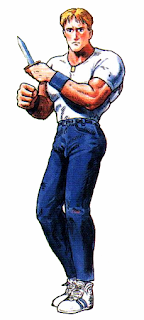Monks are humans who train their body, mind and spirit for the sake of
beating other punks improving themselves, and their belief that those trainings are complementary. Not really skilled in the arts of combat as war, like a Fighting man would, but can sometimes outperform them on certain conditions. Their prime requisite, if you really need that (I don't use them) is Wisdom.
Thry cannot use armor; save for certain special armors specially suited to their arts which consist mainly on a set of bracers, shin guards and pauldrons (+1 to +2 AC, depending on the quality). Their AC will go up as they level, anyways, representing the monk getting better at avoiding hits.
Monks have a d6 Hit Dice and XP/Attack/Saves as Cleric, and do 1d4 damage when unarmed. When they use small weapons (those that would normally deal 1d4) they deal 1d6 instead.
Monks can use any weapons, but can use their Counterattack ability only when unarmed, or using nunchucks or staves (the latter makes you drop initiative as per the Variable Weapon Damage B/X rules, but allows you +1 attack bonus on counterattacks). Other monkish weapons can appear in the monk's path, but these are the only ones which are available at the start.
SPECIAL MONK WEAPONS take the form of an improvement of the punch, typically gloves, claws or cestus. They give you +1 to hit when unarmed and do not improve damage. Its easier that way.
COUNTERATTACK is conceptually based in the Final Fantasy monk: When attacked in melee, an monk that hasn't spent his turn, be it because the enemy has the initiative or because he has chosen to held his action, can preemptivelly attack first. On a succesful hit, deal damage as usual, and the enemy attack is also deflected.
You can see the enemy roll before you choose to counterattack, and you can counterattack infinite times per turn, providing you dont die, get stunned, trip or something like that.
This is also an additional defense that complements their low AC at first levels (though only versus melee attacks) and could be a risky form of crowd control. It's the classic kung-fu scene in which Bruce Lee defends himself against a lot of mobsters.
Using a dagger won't give you any bonus, but your enemy might get scared of you. Even goblins know that punch damage is likely to be non-lethal at the discrection of the GM, but a knife is another story
SECRET TECHNIQUES can only be used when unarmed (no nunchucks no staves this time). These are abstracted by giving you one extra die from the plethora of the common dice sets (d4 to d20): when an attack is succesful and you do damage, you can roll a secret technique and add its damage to it, then the die is expended. These are only refreshed at downtime, or very slowly during the adventure: Whenever you rest, you roll all your exhausted dice: if any of them shows a 1, you recover it.
Level Progression
Level 1:
Counterattack,
Technique: 1d4 (some sort of high kick, maybe)
You can double your normal movement per turn by passing a petrification save; on a fail you must still move the normal amount.
Level 2:
Technique: 1d6
AC +1
Level 3:
Awareness (only surprised on a 1)
You take half damage from missiles and dragon breath effects, and can save for no damage at all.
Level 4:
AC +1
Your unarmed base damage becomes 1d6
Level 5:
Your fists can harm enchanted creatures at -2 (reduce this penalty for each Wisdom modifier)
Technique: 1d8
Level 6:
AC +1
You get access to a spell: Magic Missile, Mirror Image, Levitate, or any appropiate spell your GM gives to you. You can cast it at will by passing a save vs spells, with a failure being that you spend your turn for no effect. I'm not sure about this one and I think I should make an actual spell list for the monk.
Level 7:
Technique: 1d10
If you are lawful, you can turn undead
If you are chaotic, you can make enemies of less your hd save vs death when they are hit.
If you are neutral, it's a good time for you to choose your alignment
Level 8:
+1 AC (you have armor as chainmail by now)
Maybe another spell
Level 9:
Technique: You get the other 1d10 (the one with the tens). You can use this die to damage or to heal yourself at anytime by the amount rolled.
At this point you can make a dojo and attract followers as cleric
Level 10:
+1 AC
You can increase any attribute score by +2 (in order to get those cool bonuses. STR, DEX or WIS are probably the ones you want)
Level 11:
Technique: 1d12
Level 12:
+1 AC. Immunity to Geas and Quest spells
Your base unarmed damage is now 1d8
Level 13:
Technique: 1d20. You can at this point try to take down really big monsters from a single punch
Level 14:
+1 AC. Your naked AC is equivalent to a knight in shield and full plate
Level 15:
Technique: You get an additional 1d20, or an 1d30 if you can provide one.
Level 16:
+1 AC
and unarmed you might deal less damage per turn, but you can use your asploding techniques at any moment









